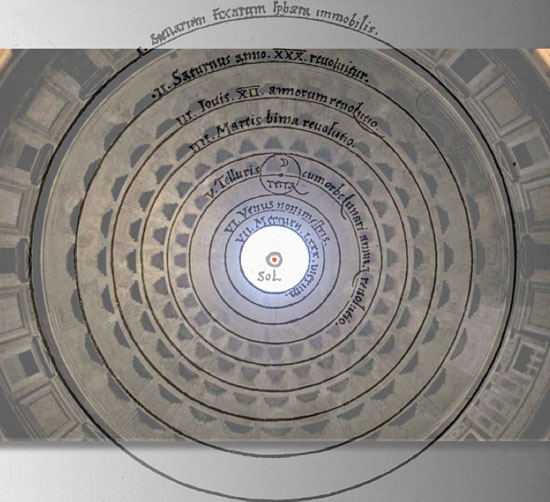Pantheonic Astronomy
 [Image: The interior of the Pantheon, as photographed by Soeren Dalsgaard].
[Image: The interior of the Pantheon, as photographed by Soeren Dalsgaard].An anonymous reader pointed out that the Pantheon was featured in NASA's Astronomy Picture of the Day last Friday.
"A testament to Roman architecture and engineering," NASA writes, "the Pantheon's dome is said to symbolize the vault of the heavens."
 [Image: A "celestogramme," looking up from within at the dome of the Pantheon, by Wolfgang Wackernagel].
[Image: A "celestogramme," looking up from within at the dome of the Pantheon, by Wolfgang Wackernagel].Seeing that, of course, makes it impossible for me to resist referring you back to BLDGBLOG's interview with Walter Murch, posted two weeks ago, in which Murch postulates a possible connection between the physical structure of the Pantheon itself and the heliocentric astronomical theories of Nicolaus Copernicus.
In other words, does the dome of the Pantheon "symbolize the vault of the heavens," as NASA writes, but in an unexpectedly literal way?
In the interview, Murch explains how he "superimposed Copernicus’s drawing [of the planetary orbits] over an image of the Pantheon’s dome – and found that the ratios of the circles in his drawing and the ratios of the circles of the Pantheon line up almost exactly. Seeing that alignment was one of those wonderful moments where you suddenly feel a strong current of connection with the past."
 [Image: Superimposition, by Walter Murch, of Copernicus's diagram of planetary orbits over a celestogramme of the Pantheon by Wolfgang Wackernagel].
[Image: Superimposition, by Walter Murch, of Copernicus's diagram of planetary orbits over a celestogramme of the Pantheon by Wolfgang Wackernagel].So is it just an interesting coincidence?
Murch goes on:
- The circumstantial evidence [for a real connection between Copernicus's drawing and the structure of the Pantheon] is compelling, but there is no reference to the Pantheon in any of Copernicus’s correspondence or in the various manuscript versions of de Revolutionibus – so we will probably never know for sure.
Nonetheless, it’s a fascinating thought: that this magnificent temple, built 1400 years before Copernicus ever saw it, designed by a pagan, Sun-worshipping Roman emperor, and later transformed into a church, may have had secretly encoded within it the idea that the Sun was the center of the universe; and that this ancient, wordless wisdom helped to revolutionize our view of the cosmos.





Comments are moderated.
If it's not spam, it will appear here shortly!
Do you think there are secret rooms below the Pantheon? What do you think they do with these rooms if they are in fact secreted below the floor? What if it is an exact mirror of the vault?
I think they use the secret rooms as a hemi-spherical roller rink.
Would it not be true that the ratio's between the rings of the dome in a photograph would change depending on the lens used to photography it?
It seems that if you used an ultra-wide or fish eye lens in this same way it would not line up in the same way with the diagram.
Hi there, Soeren Dalsgaard here, glad you liked the photo!
With concentric circles being what they are, I am not totally convinced there's necessarily a link. as far as I know, Copernicus was never in Rome, but I could be wrong there.
Post a Comment